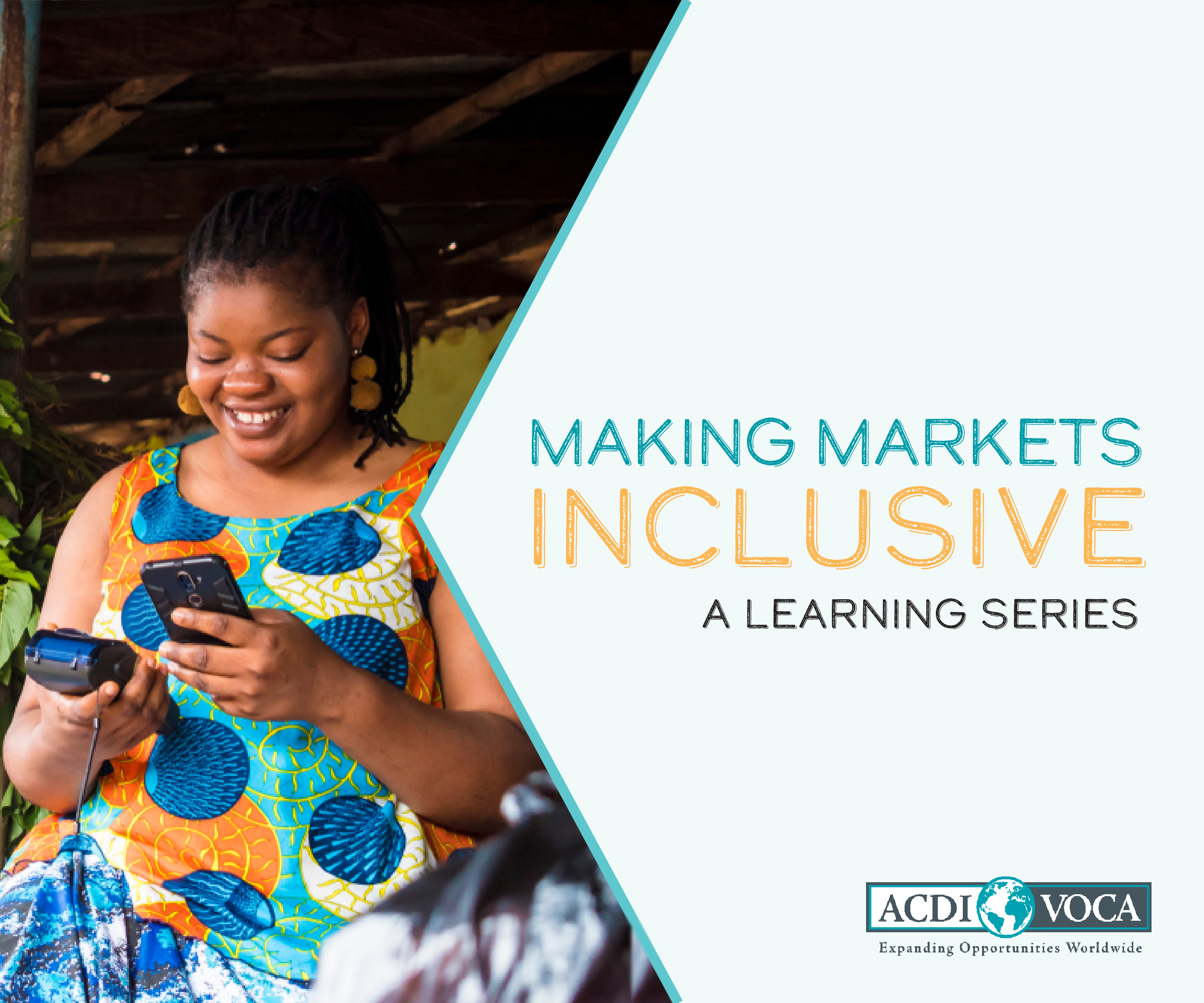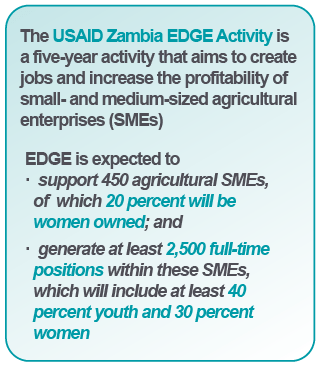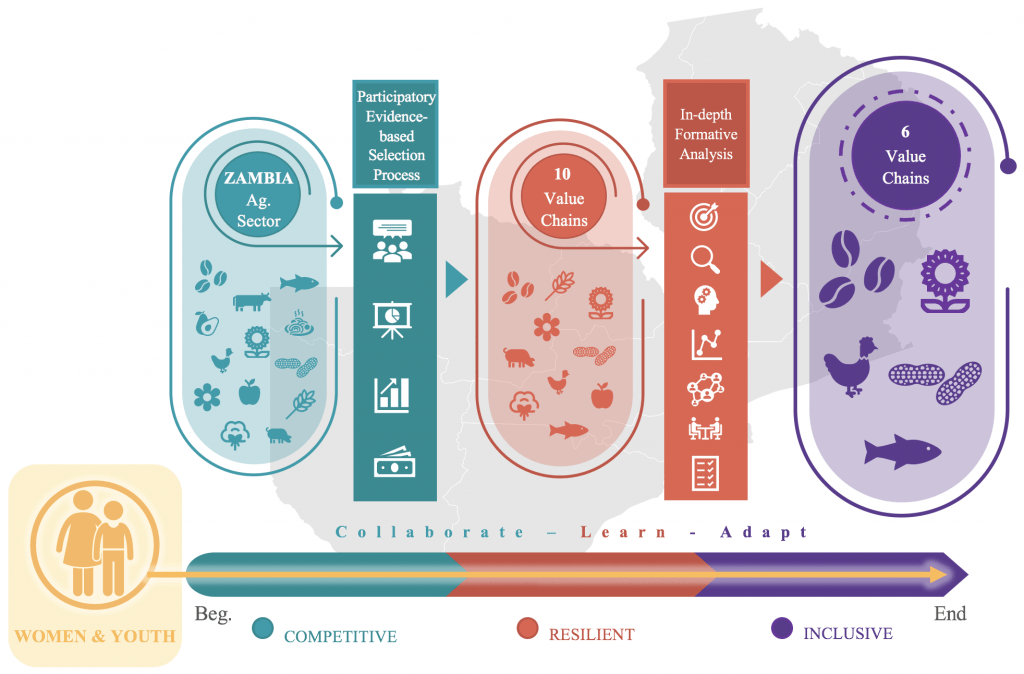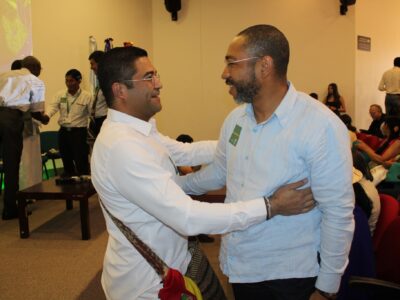
Tools and Tactics from Zambia
Many agricultural market systems development (MSD) programs have been turning their attention toward the inclusion of women, youth, and other marginalized groups as critical to not only achieving development impacts for these groups but also generating more competitive, inclusive, and resilient market systems. While robust evidence around “what works” is still limited, many agricultural MSD programs are designing, implementing, adapting, and learning from approaches aimed to bring about more effective inclusion of women and youth. In a multi-part blog series, we will explore these themes as they relate to ACDI/VOCA’s own work, sharing practical experience, challenges, and successes in an effort to further learning.

In this second blog of our Making Markets Inclusive Series, we are digging into one of the key findings from the Feed the Future Advancing Women’s Empowerment (AWE) Program research, which was presented in the first blog of the series, around the potential for market systems development (MSD) approaches to boost inclusion. The AWE Program’s landscape analysis found that being intentional about inclusion in all phases of the program leads to increased evidence of positive impacts for women and youth. Drawing on ACDI/VOCA’s early successes implementing the USAID Zambia Enterprise Development and Growth Enhanced (EDGE) Activity, we offer an example of “what works” in researching and designing for inclusion in MSD programs.
Factoring in Inclusion When Selecting Value Chains
The USAID Zambia EDGE Activity incorporated an inclusion lens at each stage of its approach to value chain selection, as shown in the graphic below. The selection process was comprised of participatory, evidence-based sector selection, in-depth formative analysis, and the identification of the most inclusive, resilient, and competitive value chains to engage with during the Activity.

Working with local partners and engaging virtually with a diverse set of stakeholders, the Activity’s team identified and profiled 20 high-potential value chains. Every profile required a section on the value chain’s potential to create inclusive jobs, though it became clear that this information was not always readily available.
Workshops with Stakeholders
To find answers, the Activity’s gender and youth specialists and one of its local partners led a stakeholder validation workshop with 15 representatives. These representatives included women and youth business owners and experts from the Ministry of Agriculture, Indaba Agricultural Policy Research Institute, and financial service providers. The workshop revealed crucial information about women and youth’s current participation in the value chains, barriers to their participation, and their interest in and opportunities for working in the value chains in the future. This information was combined with market research from a survey of male- and female-owned SMEs that asked about the potential for increases in the participation of women and youth entrepreneurs and employees in the value chains, among other things. The findings played a critical role in arriving at the 10 top-ranking value chains to carry forward into the formative analysis stage.
Weighing the Selection Criteria
The Activity used specific criteria to analyze, score, and rank value chains against each other during this stage. The team assigned criteria with different weights based on the Activity’s objectives and the nature of its market systems approach. One such criteria was the value chain’s potential for inclusive growth. It included two indicators: the potential for growth and participation — via production, off-farm employment, or entrepreneurship — in roles for both women and youth.
The inclusive growth criteria was given the highest weight, at 30 percent, because of the Activity’s strong commitment to creating inclusive entrepreneurship and employment opportunities. This was important because it meant that the value chains selected were not only currently inclusive of women and youth but also had the potential for increased participation and upgraded roles for women and youth, especially in activities beyond production (e.g., input sales). The ultimate selection of value chains included a mix of those that were already inclusive and those with the potential for more engagement as the sector grows.
Gender, Youth, and Social Inclusion Analysis
The in-depth formative analysis phase also included a more traditional gender, youth, and social inclusion analysis. The aim of the analysis was to understand both the broader situation of women and youth, including social norms and decision making, as well as reasons for the current division of responsibilities and its effect on the distribution of rewards and incentives among all people within the market system. The team conducted focus group discussions with women and youth and led a participatory value chain mapping workshop with private and public sector stakeholders. Findings from the analysis were used to develop a gender, youth, and social inclusion strategy and corresponding action plan to guide the Activity’s inclusion efforts.
From Research to Design
The Activity is beginning to facilitate the participatory design of interventions. During the co-creation process, the Activity will share the results of the analyses with partners, as it works with SMEs and financial service providers to identify and set goals based on mutually beneficial incentives. The Activity has already integrated inclusion considerations into its process for identifying such partners using score card assessments. The team asked specific questions about inclusion strategies and existing products or services targeted to women and youth. They gave each response the maximum weight possible of 5 percent.
As Tidzitwa Zulu, the Activity’s Director of Social Inclusion and Innovation, said, applying an inclusion lens early in the project’s start-up including formative research is vital, “as it sets a strong foundation for achieving impact while having inclusion at the core of all project activities.” These lessons from Zambia are being applied to the design phases of ACDI/VOCA’s upcoming MSD programs, especially around inclusion-specific market research paired with gender, youth, and social inclusion analyses.
Have these tactics for inclusion in project design spoken to a challenge you are facing with your own MSD program? Are you interested in how this could be applied in other phases of MSD? Follow along as we explore these topics (and many more!) over the coming months in this multi-part blog series.
For More in the Making Markets Inclusive Series
Read the first post in the series, “How Market Systems Development Programs Can Boost the Inclusion of Women, Youth, and Other Marginalized Groups,” published March 2, 2021.
Read the third post in the series, “Tips for Advancing Inclusion Through Co-Creation with the Private Sector, Part 1,” published May 4, 2021.
Read the fourth post in the series, “Making Markets Inclusive: Tips for Advancing Inclusion Through Co-Creation with the Private Sector, Part 2,” published May 27, 2021.
Comments






